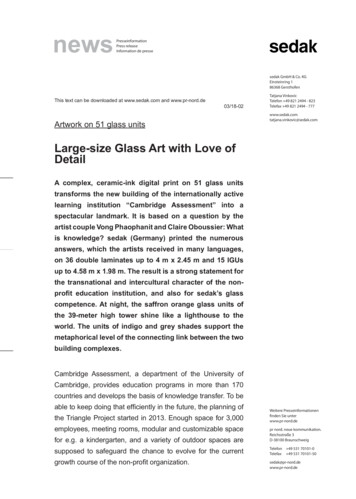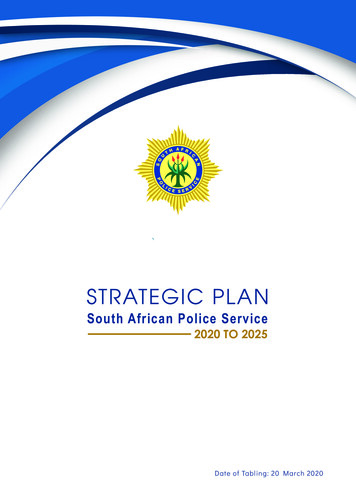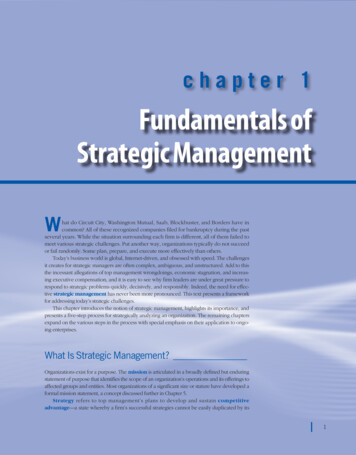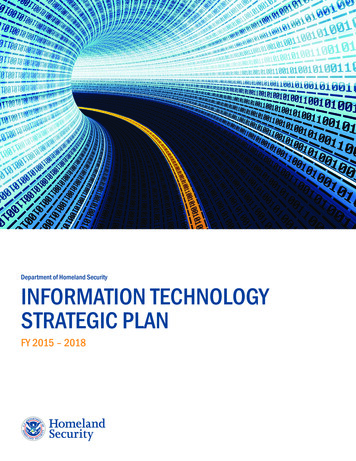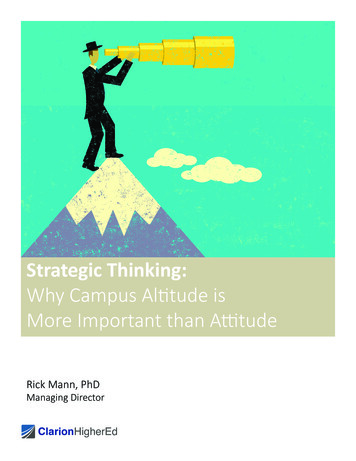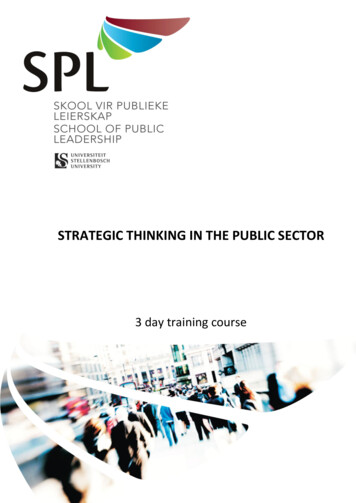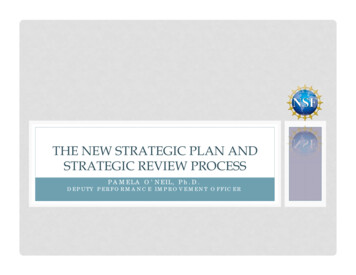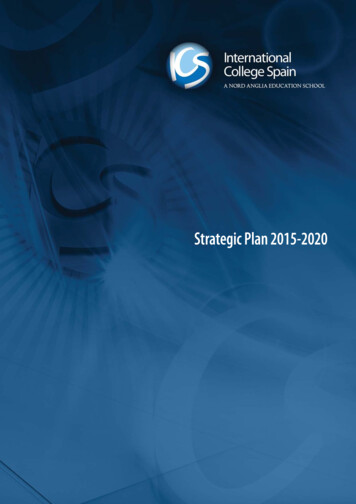
Transcription
Strategic Plan 2015-2020
INTRODUCTIONThis strategic plan was developed from the combined work of representatives from all sections ofthe school community-parents, teachers, students, school leaders and advisory board members.In particular members of formal structures such as the school senior leadership team, the executivecommittee of the Parents’ Association (FOICS), the Student Council and the Advisory Board werejoined by volunteers from the parent body and employees of the school (teachers andadministration). A 5-D appreciative inquiry methodology was used starting from the positivequestion of what do we do which is great and how can we do more of it? The ‘define’ and ‘discover’stages led to ‘dream’ and ‘design’ stages and will be completed with a ‘deliver’ stage. The plan tookinto account data and opinion drawn from a number of sources including accreditation andinspection reports and surveys and questions from samples of the community.The aim of the strategic plan is to provide the vision and objectives to guide annual schooldevelopment over the next five years. It is a continuous process reflecting the ever changing natureof the internal school and external environment with a built in annual cycle for thinkingstrategically, monitoring progress and for planning for the delivery against the vision andobjectives for the next year ahead. In this way the establishment of standing strategic auditingcommittees made up of representatives from all sections of the community can, within theoverarching vision and goal, embed innovative strategic thinking into the structure of the schooland enable to strategic plan to adapt flexibly to changing circumstances and priorities.THE FIVE STAGESTHE 5D APPROACH TO AN APPRECIATIVE ENQUIRY
THE INTERNATIONAL COLLEGE SPAIN ICS STORY AND MISSIONInternational College Spain is one of the leading international schools in Europe, established for over 30 years. We are the only school in Madridthat offers the three prestigious InternationalBaccalaureate programmes in English to all of our students. We deliver great academic results andthe best education of the ‘whole child’ in the city.Our 56 nationalities define the international character of International College Spain and significantly contribute to confident, principled, respectful andopen-minded students who are ambitious for their futures and who will make a difference in the world. Our teachers are relentlessly committed tosupporting every student in nurturing their individual and unique skills and interests. We are part of the Nord Anglia Education family of premiuminternational schools, giving us a unique linkage in Madrid to other schools and opportunities worldwide. In summary, we believe that InternationalCollege Spain gives students in Madrid the best possible start to adult life.The philosophy of the school is to provide students with a high quality international education which places a strong emphasis on fostering respect for otherpeople’s identity and culture. This is achieved through the provision of a challenging curriculum which develops critical, principled thinking within a positivelearning environment and which addresses the students’ academic, social, emotional, physical, technological, aesthetic and moral needs. The school alsopromotes an active interest in learning, enabling students to acquire the skills, attitudes and qualifications necessary for them to become successful,responsible citizens.THE SCHOOL’S STRATEGIC ‘BIG AUDACIOUS GOAL’ (Collins, 2001*)This strategic plan is designed to support our identity and mission. Part of the work of the strategic plan is to simplify and sharpen this identity and mission.The overarching aim of the ICS Strategic Plan is to:“Establish ICS Madrid as the unrivaled leader for innovation in international education”Each operational area’ s vision, objective, plan and action is designed to be coherent with the school’s mission, identity and strategic ‘big audacious goal’.*J. Collins. ‘Good To Great’ (RH Business Books, 2001)
THE PLANNING PROCESSWithin the strategic plan five operational and strategic areas were identified. Five cross-community workshops were established led by anelected facilitator and secretary to guide the process. The facilitators attended an orientation session to establish the values, skills and strategiesto ensure a participatory, conversational based approach to thinking, planning and decision making. An orientation session for all participants,a full day workshop and four subsequent workshop planning sessions were held to establish a strategic vision, four strategic objectives to deliverthe vision and the first year’s action plan of tasks for each operational area.Once the initial planning stage is complete standing committees responsible for monitoring progress, planning for implementation and thinking innovativelyabout the future of the school will be established. Each year operational tasks will be identified for implementation by the school leadership team for thefollowing year. These will be included in the annual operational targets and development plans for the school.THE STRATEGIC AREAS
LEARNING AND TEACHING DEVELOPMENTSTRATEGIC VISIONWe see ICS as a school where Teaching and Learning will give every student the opportunity to adapt, succeed and affect positive changes in a globalisedworld. The values and attributes of the International Baccalaureate Organisation (IB) programmes and Learner Profile are embedded and demonstratedacross all subjects and by everyone in the school community. Our curriculum and community is constantly developing to reflect our position at a local,national and international level. Teaching and Learning is aspirational and adventurous and encourages the continual improvement of every student andteacher. It exploits our skills and celebrates our achievements. Being a part of the ICS community is to be caring, principled and open minded. We areindividuals who share the common goal of a better world. With the right support, we can do anything.OBJECTIVES To develop an innovative and flexible curriculum that changes with the times and reflects contemporary, global issues. To enable useful, effective and clear communication between all members of our community. To encourage and facilitate the effective inclusion of new technology in every subject. To encourage and facilitate more collaboration across departments and with the local community. To embed and make more explicit the IB philosophy and Learner Profile attributes across all aspects of the curriculum. To encourage greater risk taking across all aspects of teaching and learning, embedding a spirit of adventure and inquiry.LEARNING AND TEACHING DEVELOPMENT ACTION PLAN 2015 16Objective (What)1 To embed and make more explicitthe IB philosophy and LearnerProfile attributes across all aspectsof the rincipledTask (How)1.1By making links to the IB Learner Profile explicit in the delivery of lessons; through unit andlesson plans; in displays and posters around school1.2By making the IB Learner Profile visible beside every display board1.3By using the language of the IB Learner Profile in reports and communications home1.4By introducing a rewards system to enable teaching staff to reward students for displaying IBLearner Profile Attributes1.5By building Secondary Tutor Time and Assembly Programmes around the IB Learner Profileattributes1.6By providing directed planning time for teachers to develop and update the curriculum planningdocuments around the IB Learner Profile
Learning and Teaching Development Action Plan 2015-16 (continued)Objective (What)2 To develop an innovative andflexible curriculum that changeswith the times and reflectscontemporary, global issuesTask (How)2.1 By introducing an annual curriculum review and renewal cycle to ensure that every subject areareviews and re-writes at least one new unit or scheme of work per grade level per year2.2 By introducing a management mechanism to assure that existing schemes of work include anynew and relevant information resulting from the OCC, examiner or moderator feedback2.3 By exploring ways in which Teachers can be given non-contact time for planning new schemes ofwork such as allowing for departments to use cover for absent colleagues flexibly e.g. eachteacher can access 5 hours of cover/year for planning.2.4 In addition to the school’s professional development and workshop programme by generatingnew ideas and innovative practice through engagement in professional networks and onlineforums and through opportunities for Teachers to observe other lessons, teach collaboratively,and visiting other schools.2.5 By exploring timetabled opportunities for collaborative planning3 To enable useful, effective and clearcommunication between allmembers of our community3.1 By articulating a coherent strategy and procedure for the use of Managebac, iSAMS and OneDrivewhich includes the statement of a clear purpose for each software programme forcommunication and for storage such as;ManageBac students-parents-teachers focused on learning developmentiSAMS teachers-teachers-parents focused on data, information and protection, record keeping,achievements and attitude, behaviourOneDrive students-staff for file storage3.2 By agreeing and implementing a meeting protocol to ensure focused and effective meetings forschool staff and which is differentiated by content3.3 By identifying together with representatives of the staff means for improving communicationsand consultation between the SLT and the staff such as the introduction of morning plenarybriefings3.4 By introducing opportunities for student advisory meetings across the whole school whereteachers can share information about student progress and behaviour and share strategies forsupport or intervention.3.5 By establishing a Transition Team to assist in the effective, relevant, and focused support ofstudents moving from Primary to Secondary Schools and which will focus on introducing tutorsand teachers to parents in a more social meeting at the start of the year3.6 By introducing curriculum presentations at the start of each new IB programme to inform parentsof structure and expectations.3.7 By reviewing, together with the Faculty, the way in which Parent Teacher consultations areorganized either around programmes (6-10, 11-12) or by learning phases (6,7,8/ 9-10/ 11-12)
Learning and Teaching Development Action Plan 2015-16 (continued)Objective (What)4 To encourage and facilitate theeffective inclusion of newtechnology in every subject.Task (How)4.1 By identifying, articulating and communicating an ICT Integration Strategy focusing on theeffective and reliable provision of minimum requirements to deliver great learning in classrooms(such as Wi-Fi, email, access to laptops or tablets, data storage and access, projector, speakersetc.)4.2 By identifying, articulating and communicating an ICT Integration Strategy which includessystems for devolving accountability and budgetary responsibility for training and software todepartmental level4.3 By identifying, articulating and communicating an ICT Integration Strategy where at least oneteacher from every department or grade level is identified as an ICT Champion and is regularlytrained and responsible for promoting the use of technology in their area5 To encourage and facilitate morecollaboration across departmentsAND with the local community.5.1 By establishing a school wide trips and visits policy and annual plan which includes events atdepartmental, grade level and inter-disciplinary level and where the organization of which issupported by an administrative position5.2 By identifying time and directing shared objectives to teachers to enable collaboration,discussion and planning of new ideas5.3 By establishing an organizational theme of ‘Thinking Globally and Acting Locally’ as the driver forcoordinating local opportunities, visits, connections and support from local businesses andorganisations.5.4 By ensuring greater use of the NAE Global Classroom and Inter-School Projects6 To encourage greater risk takingacross all aspects of teaching andlearning, embedding a spirit ofadventure and enquiry.6.1 By addressing the desire for teacher autonomy with the need for accountability withinPerformance Management and Appraisal systems which encourage a culture where the risk offailure is reduced.
FINANCE AND FACILITIES DEVELOPMENTSTRATEGIC VISIONWe see ICS as a school where the school’s Facilities (buildings, materials, equipment and spaces) and Finances (resources, investment plans and financialperformance) provide the opportunities for students in their learning journey to become successful and responsible members of local, national and globalcommunities.OBJECTIVES To develop the school facility as a comfortable physical and psychological working environment To ensure decisions about facility management and site development are coherent with the school’s mission and vision To assure the highest standards of safety support all school activities To improve the provision of educational support services and the availability of learning spaces for teachers and students To define and implement a medium term budgetary and financial strategy which will permit site development and establish preconditionsfor sustainable growth To develop the school’s financial structure, processes and performance for the school to be able continuously invest in facilities andinfrastructure which reflect the IB’s philosophy and Learner ProfileFINANCE AND FACILITIES DEVELOPMENT ACTION PLAN 2015 16Objective (What)1 To define and implement a mediumterm budgetary and financialgrowth strategy which will permitsite development and establishpreconditions for sustainablegrowth.Task (How)1.1 By building a business model for an expansion project and a future based on a school with acapacity for 1000 students.1.2 By making a formal proposal to the Corporation1.3 By engaging architects and site development experts to provide a feasible design within thebusiness model’s budgetary and financial parameters1.4 By getting final approval from Nord Anglia's Board.1.5 By being ready to use the additional capacity created by September 20171.6 By creating additional spaces in the short term through the enlargement of thecafeteria and finding additional parking space1.7 By introducing a system for coordinating with the rest of the strategic groups to identifyintermediate needs and which imply facilities development or infrastructure qualityimprovement2 To develop the school’s financialstructure, processes andperformance for us to be ablecontinuously invest in facilities andinfrastructure which reflect the IB’sphilosophy and Learner Profile.2.1 By exploring possibilities for renting equipment and material resources to maintain quality andembed a process of continuous investment2.2 By implementing an annual administrative system and process for categorising, prioritising andevaluating potential capital expenditure and investment projects2.3 By exploring ways of negotiating an annual agreement, understanding or formula comprised ofany of the key metrics determined by the company for determining capital expenditure andwhich is directly related to institutional financial performance and the wider needs of thecorporation.2.4 By influencing the formula for determining the level of capital investment by negotiating withthe Regional Office for changes within the structure of the budget such as an exchange ofamortization for renting, to look at ways to reduce the costs of physical materials for electronicones as well improvements in facility to reduce waste and thus costs of maintenance whilstremaining true to the values of the IB Learner Profile3 To develop the school facility as acomfortable physical andpsychological working environment3.1 By identifying measures which can improve the ecological and environmental standard withinthe school and reduce environmental waste
MARKETING AND COMMUNICATIONS DEVELOPMENTSTRATEGIC VISIONWe see ICS as a school where marketing and communications target, capture and inform our different audiences by engaging and energising them topromote the vision and mission of the school. We make a commitment to positively and proactively communicate the benefits of an international IBeducation in an innovative and progressive way.OBJECTIVES To establish and position ICS as the leading international school in Spain by building effective brand awareness To engage the whole ICS community in order to foster a sense of pride and belonging which create advocates for the school’s mission,vision and offer To develop a marketing and communication plan reaching each segment of the target market through customised messages andcommunication channelsMARKETING AND COMMUNICATIONS DEVELOPMENTACTION PLAN 2015 16Objective (What)1 To establish and position ICS as theleading international school in Spainby building effective brandawarenessTask (How)1.1 By establishing the NAE strategy for re-branding the organization and identifying the ways tomake our branding strategy coherent with this1.2 By working with the Finance and Facilities Group to link site development to the image of schooland to the brand and then by promoting this to the community through parental touch points1.3 By applying an ‘Apple’ style marketing and communications strategy which focuses on identity or‘way of life’ rather than function1.4 By identifying and implementing measures to refresh the image of the school internally toreflect this2 To engage the whole ICS communityin order to foster a sense of prideand belonging which createadvocates for the school’s mission,vision and offer2.1 By appointing an inspirational leader responsible for developing student engagement and schoolspirit and which include school songs, banners, cheerleading, motto, mascots etc.2.2 By generating greater student pride and engagement through further opportunities for studentparticipation and representation and acknowledge and reward this more effectively throughassemblies, certificates and prizes2.3 By making student achievement more visible through the displays and the websiteExplore ways in which students can build brand awareness with outside agencies and businessesthrough work practice possibilities
TECHNOLOGY DEVELOPMENTSTRATEGIC VISIONWe see ICS as a school where technology enhances and, where appropriate, transforms the inquiry based creative and collaborative learning experiencefor each student.OBJECTIVES To articulate a strategy which will enable ICS to access, use and benefit from a range of education related software and hardware To establish an ICT budget and investment map for the school To identify an ecosystem of fit for purpose IT tools to support the school's ICT strategy To support the implementation of ICT in the school with an annual professional development plan To identify a leadership structure for the implementation and management of ICT at the school To identify the current and future technology requirements of ICS students at the various grade levels and build these into the entire curriculum
TECHNOLOGY DEVELOPMENT ACTION PLAN 2015 16Objective (What)1 To articulate a strategy which willenable ICS to access, use and benefitfrom a range of education relatedsoftware and hardwareTask (How)1.1 By articulating the objectives and philosophy which underpins our approach to ICT at ICS.1.2 By drawing up an ICT development plan involving five key areas to include:Technical InfrastructureAdministrative SystemsCommunity Outreach and CommunicationsEducative SystemsProfessional Development and Training1.3 By establishing an ICT Steering Committee to guide the development of ICT at ICS to include - amember of the SLT, an ICT Coordinator Primary, an ICT Coordinator Secondary, the IT TechnicalSupport Manager, the Information Systems Manager and the Business Manager- and replacingthis later a Director of IT1.4 By identifying the technology enhanced approach to teaching and learning and the consequentlearning needs of students at school2 To establish an ICT budget andinvestment map for the school2.1 By introducing a budget structure and annual process for budgeting including requirements forsection and departmental requests2.2 By identifying a purchase and supply procedure for costing items within the budget2.3 By investigating with NAE finance and leasing solutions to support investment in ICT at ICS3 To identify an ecosystem of fit forpurpose IT tools to support theschool's ICT strategy3.1 By describing what an 'integrative school' school environment looks like at ICS3.2 By mapping out the various functions and applications for the systems to be used within theschool- who and what does what and what do we want them to do?3.3 By identifying the criteria for evaluating new systems and tools against the integrated virtuallearning environment3.4 By identifying and assessing new and existing ICT tools and systems against these criteria4 To support the implementation ofICT in the school with an annualprofessional development plan4.1 By identifying the annual ICT related PD requirements for submission to the school's PDCommittee/SLT4.2 By providing training and specialist support to teachers in iPad use4.3 By providing training and specialists support in the introduction and implementation of ISAMSinformation management system
PEOPLE STUDENT & STAFF DEVELOPMENTSTRATEGIC VISIONWe see ICS as a school where students, teachers and staff feel valued, encouraged and stimulated to realise their true and full potential, supported everystep of the way, ready to become leading and caring global citizens.OBJECTIVES To develop opportunities for pupils to explore, innovate and create within the various disciplines taught using information technology To establish and deliver a fully documented programme of personal, social, emotional, moral and health education for parents, staff andstudents in order to develop all school community members holistically and to contribute to a mindful and balanced sense of theindividual within a community To develop an approach or programme of personalisation in the educational programme where a teachers’ role develops into that of amentor focusing on individualized learning and target setting, high performance and a commitment to continuous improvement To structure and integrate careers, university and post-secondary guidance support and tailor it to students needs and strengths from Grade 9 To develop and enhance a school wide performance management review appraisal process for each member of staff To develop an alternative pathways to success programme including a formal transition to the workplace programme with local businessesand companies To develop the global profile of all members of the community with an annual global outreach events programme plan such as thehosting of three international level events at ICS
PEOPLE STUDENT & STAFF DEVELOPMENT ACTION PLAN 2015 16Objective (What)1 To establish and deliver a fullydocumented programme ofpersonal, social, emotional, moraland health education for parents,staff and students in order todevelop all school communitymembers holistically and tocontribute to a mindful andbalanced sense of the individualwithin a communityTask (How)1.1 By reviewing the selection process and job specification of the secondary tutor and primary areacoordinator in order to develop a 360º monitoring of students' well-being1.2 By introducing a formal training programme for each of above (tutoring, mentoring,coordinating);1.3 By establishing a clinical type referral and intervention system that will instantly flag up astudent with health related, emotional, social or home based problems1.4 By introducing into the Tutor programme tutor led activities to build team building as part of astart of school year bonding process1.5 By introducing programmes to help staff and students manage stress and build intellectual,emotional and social resilience including recognised programmes in Mindfulness.2 To develop an approach orprogramme of personalisation in theeducational programme where ateachers’ role develops into that of amentor focusing on individualizedlearning and target setting, highperformance and a commitment tocontinuous improvement2.1 By creating a bank of individual and cohort student performance and achievement data collectedwhich would include a student’s profile, test results, benchmarks etc. and which can be analysedand used over time to monitor progress and indicate interventions and support3 To structure and integrate careers,university and post-secondaryguidance support and tailor it tostudents needs and strengths fromGrade 93.1 Identify common approaches and materials that ensure the separate university counsellors usingspecialists in (Spain/U.S.A./U.K (& Europe)4 To develop and enhance a schoolwide performance managementreview and appraisal process foreach member of staff4.1 By working with faculty to enhance, extend and improve the Performance Management Reviewsystem that is in place2.2 By providing additional training to all staff to improve personalised education for students3.2 By improving the use of open source/on-line information courses, tutorials etc.4.2 By adding a system to gather student feedback in upper grades4.3 By identifying further ways to assessing teaching staff attitudes and engagement.5 To develop an alternative pathwaysto success programme including aformal transition to the workplaceprogramme with local businessesand companies5.1 By investigated potential alliances with specific businesses for non-vocational training experiencefor students or student centred programmes to facilitate transition to work such as the JuniorAchievement Young Enterprise6 To develop the global profile of allmembers of the community with anannual global outreach eventsprogramme plan such as the hostingof three international level eventsat ICS6.1 By organising three events per year
CHANGE AND THE STRATEGIC PARAMETERSThe Strategic Plan is designed to be responsive to change within and outside its community yet any changes to this plan should meet the following criteria: The change is consistent with the school’s identify and mission The change is within the overarching strategic big audacious goal The change makes a contribution to children’s learning The change can be resources and appropriately implemented within the lifetime of the planSTRATEGIC PLANNING COMMITTEE MEMBERSFinance and Facilities DevelopmentRaquel ParienteRamin DjalaliKeith MaddisonAna OrdásWasil RezkJavier BravoSenior Leadership TeamSenior Leadership TeamFOICSFOICSStudentsStudentsLearning and Teaching DevelopmentJennifer BarnettDolores MoralesAngeles SanchezCorey BikeLucy GroveNélida AntuñaLousie ClementAna Carolina HebergerAlejandra Yael RuvinskySenior Leadership TeamStaffStaffStaffStaffAdvisory BoardFOICSParentsStudentsMarketing and CommunicationsAurora LópezSharon SpencerFlora RueJuan Antonio YañezMargo MaddisonRicardo Polizzy CarbonelliSenior Leadership TeamSenior Leadership TeamAdvisory BoardAdvisory BoardFOICSParentsPeople (Staff & Student) DevelopmentMª Carmen CaballeroJayne RoumianAnne PietersmaDavid WolfePatricia RojasBeatrice MisrahiMaría de Mena PernilStaffStaffFOICSAdvisory BoardParentsParentsParentsTechnology DevelopmentBarry HughesMaria Garcia NielsenFabio ChesiniJacob SpencerDavid BaileyJosema MataSenior Leadership TeamAdvisory BoardParentsStudentsStaffStaff
Calle Vereda Norte 328109, La MoralejaMadridTel: 34 91 650 23 98Fax: 34 91 650 10 35www.icsmadrid.orginfo@icsmadrid.org
overarching vision and goal, embed innovative strategic thinking into the structure of the school and enable to strategic plan to adapt flexibly to changing circumstances and priorities. INTRODUCTION . 'Good To Great' (RH Business Books, 2001) THE INTERNATIONAL COLLEGE SPAIN ICS STORY AND MISSION. THE PLANNING PROCESS THE STRATEGIC AREAS

